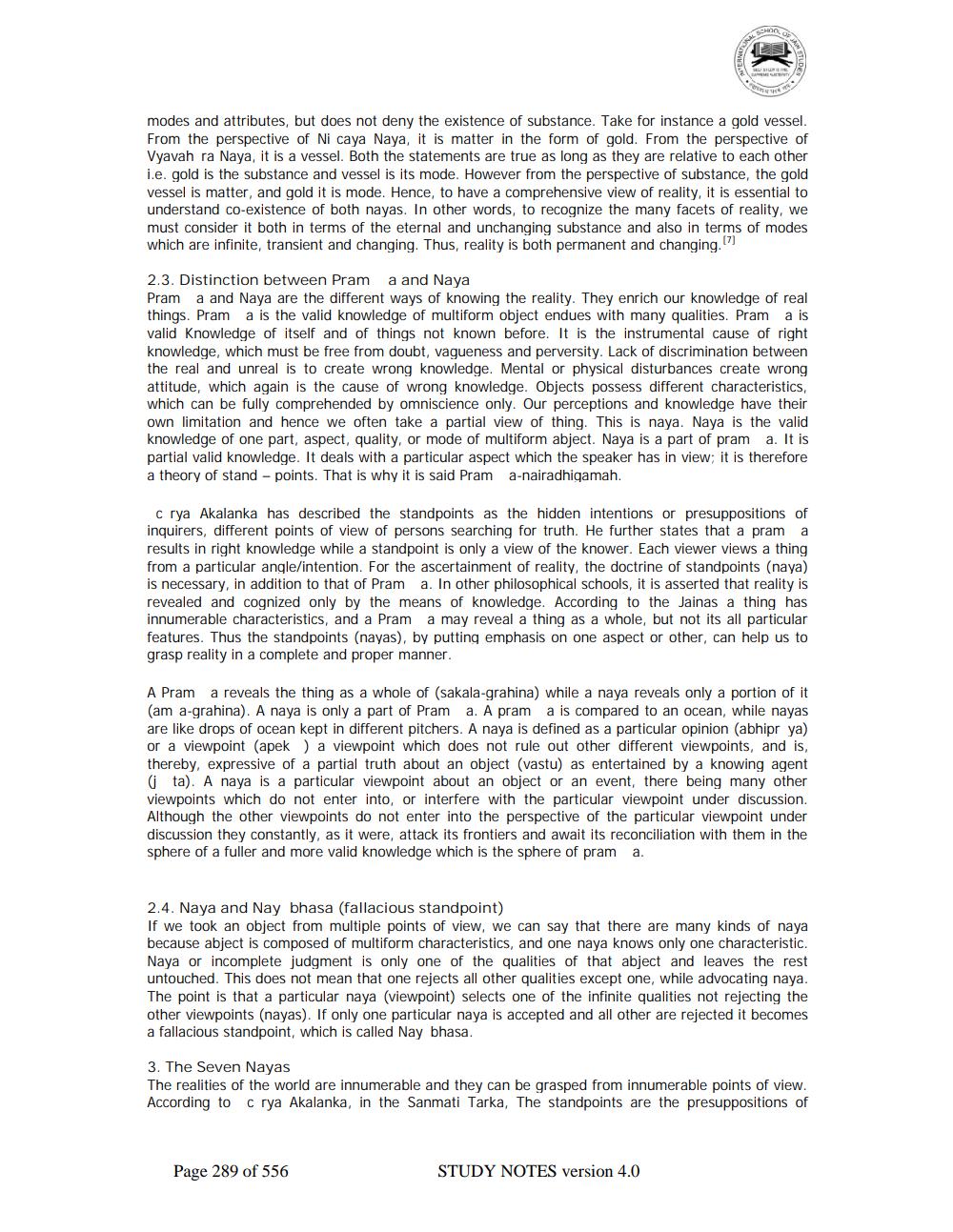________________
modes and attributes, but does not deny the existence of substance. Take for instance a gold vessel. From the perspective of Ni caya Naya, it is matter in the form of gold. From the perspective of Vyavah ra Naya, it is a vessel. Both the statements are true as long as they are relative to each other i.e. gold is the substance and vessel is its mode. However from the perspective of substance, the gold vessel is matter, and gold it is mode. Hence, to have a comprehensive view of reality, it is essential to understand co-existence of both nayas. In other words, to recognize the many facets of reality, we must consider it both in terms of the eternal and unchanging substance and also in terms of modes which are infinite, transient and changing. Thus, reality is both permanent and changing."
2.3. Distinction between Pram a and Naya Pram a and Naya are the different ways of knowing the reality. They enrich our knowledge of real things. Pram a is the valid knowledge of multiform object endues with many qualities. Pram a is valid Knowledge of itself and of things not known before. It is the instrumental cause of right knowledge, which must be free from doubt, vagueness and perversity. Lack of discrimination between the real and unreal is to create wrong knowledge. Mental or physical disturbances create wrong attitude, which again is the cause of wrong knowledge. Objects possess different characteristics, which can be fully comprehended by omniscience only. Our perceptions and knowledge have their own limitation and hence we often take a partial view of thing. This is naya. Naya is the valid knowledge of one part, aspect, quality, or mode of multiform abject. Naya is a part of pram a. It is partial valid knowledge. It deals with a particular aspect which the speaker has in view; it is therefore a theory of stand - points. That is why it is said Pram a-nairadhigamah.
c rya Akalanka has described the standpoints as the hidden intentions or presuppositions of inquirers, different points of view of persons searching for truth. He further states that a pram a results in right knowledge while a standpoint is only a view of the knower. Each viewer views a thing from a particular angle/intention. For the ascertainment of reality, the doctrine of standpoints (naya) is necessary, in addition to that of Pram a. In other philosophical schools, it is asserted that reality is revealed and cognized only by the means of knowledge. According to the Jainas a thing has innumerable characteristics, and a Pram a may reveal a thing as a whole, but not its all particular features. Thus the standpoints (nayas), by putting emphasis on one aspect or other, can help us to grasp reality in a complete and proper manner.
A Pram a reveals the thing as a whole of (sakala-grahina) while a naya reveals only a portion of it (am a-grahina). A naya is only a part of Pram a. A pram a is compared to an ocean, while nayas are like drops of ocean kept in different pitchers. A naya is defined as a particular opinion (abhipr ya) or a viewpoint (apek) a viewpoint which does not rule out other different viewpoints, and is, thereby, expressive of a partial truth about an object (vastu) as entertained by a knowing agent
i ta). A naya is a particular viewpoint about an object or an event, there being many other viewpoints which do not enter into, or interfere with the particular viewpoint under discussion. Although the other viewpoints do not enter into the perspective of the particular viewpoint under discussion they constantly, as it were, attack its frontiers and await its reconciliation with them in the sphere of a fuller and more valid knowledge which is the sphere of pram a.
2.4. Naya and Nay bhasa (fallacious standpoint) If we took an object from multiple points of view, we can say that there are many kinds of naya because abject is composed of multiform characteristics, and one naya knows only one characteristic. Naya or incomplete judgment is only one of the qualities of that abject and leaves the rest untouched. This does not mean that one rejects all other qualities except one, while advocating naya. The point is that a particular naya (viewpoint) selects one of the infinite qualities not rejecting the other viewpoints (nayas). If only one particular naya is accepted and all other are rejected it becomes a fallacious standpoint, which is called Nay bhasa.
3. The Seven Nayas The realities of the world are innumerable and they can be grasped from innumerable points of view. According to crya Akalanka, in the Sanmati Tarka, The standpoints are the presuppositions of
Page 289 of 556
STUDY NOTES version 4.0




